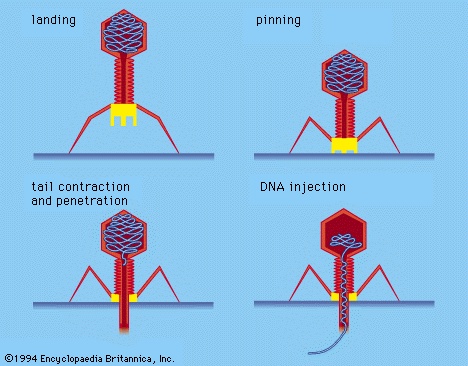bacteriophage
virus
also called phage, or bacterial virus,
any of a group of viruses that infect bacteria. Bacteriophages were discovered independently by Frederick W. Twort in Great Britain (1915) and Félix d'Hérelle (Hérelle, Félix d') in France (1917). D'Hérelle coined the term bacteriophage, meaning “bacteria eater,” to describe the agent's bacteriocidal ability.
Thousands of varieties of phage exist, each of which may infect only one type or a few types of bacteria. Phages are classified in a number of virus families, including Inoviridae and Microviridae. Like all viruses, phages are simple organisms that consist of a core of genetic material (nucleic acid) surrounded by a protein capsid. The nucleic acid may be either DNA or RNA and may be double-stranded or single-stranded. There are three basic structural forms of phage: an icosahedral (twenty-sided) head with a tail, an icosahedral head without a tail, and a filamentous form.
 During infection a phage attaches to a bacterium and inserts its genetic material into the cell. After this a phage follows one of two life cycles, lytic (virulent) or lysogenic (temperate). Lytic phages take over the machinery of the cell to make phage components. They then destroy, or lyse, the cell, releasing new phage particles. Lysogenic phages incorporate their nucleic acid into the chromosome of the host cell and replicate with it as a unit without destroying the cell. Under certain conditions lysogenic phages can be induced to follow a lytic cycle.
During infection a phage attaches to a bacterium and inserts its genetic material into the cell. After this a phage follows one of two life cycles, lytic (virulent) or lysogenic (temperate). Lytic phages take over the machinery of the cell to make phage components. They then destroy, or lyse, the cell, releasing new phage particles. Lysogenic phages incorporate their nucleic acid into the chromosome of the host cell and replicate with it as a unit without destroying the cell. Under certain conditions lysogenic phages can be induced to follow a lytic cycle.Phages have played an important role in laboratory research in the 20th century. The first phages studied were those designated type 1 (T1) to type 7 (T7). The T-even phages, T2, T4, and T6, were used as model systems for the study of virus multiplication. Alfred Day Hershey and Martha Chase used the T2 bacteriophage in a famous experiment in 1952 which supported the theory that DNA is the genetic material. Certain phages, such as lambda, Mu, and M13, are used in recombinant DNA work. The phage ϕX174 was the first organism to have its entire nucleotide sequence determined, a feat that was accomplished by Frederick Sanger (Sanger, Frederick) and colleagues in 1977.
Soon after making their discovery, Twort and d'Hérelle began to use phages in treating human bacterial diseases such as bubonic plague and cholera. Phage therapy was not successful, and after the discovery of antibiotics in the 1940s it was virtually abandoned. With the rise of drug-resistant bacteria in the 1990s, however, the therapeutic potential of phages has received renewed attention.
- Rowlandson, Mary
- Rowlandson, Thomas
- Rowlatt Acts
- Rowley, William
- Rowling, J.K.
- Rowling, Sir Wallace Edward
- Rowntree, B Seebohm
- Rowse, A.L.
- Rowson, Susanna
- Roxana
- Roxas
- Roxas, Manuel
- Roxburghshire
- Roxbury
- Roxy Music
- Roy Acuff
- Royal Academy of Arts
- Royal Academy of Dramatic Art
- Royal Air Force Museum
- Royal Air Force, The
- Royal Albert Hall
- Royal and Ancient Golf Club of St. Andrews
- royal antelope
- Royal Armouries
- Royal Astronomical Society